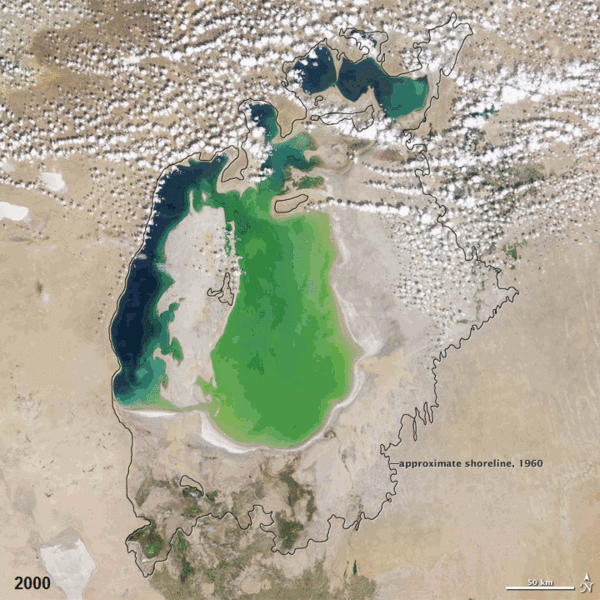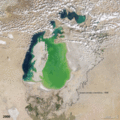Dataja:Aral sea.gif

Wulkosć tutoho přehlada: 600 × 600 pikselow. Druhe rozeznaća: 240 × 240 pikselow | 480 × 480 pikselow | 720 × 720 pikselow.
Wersija z wyšim rozeznaćom (720 × 720 pikselow, wulkosć dataje: 3,16 MB, typ MIME: image/gif, Bjezkónčna sekla, 12 wobłukow, 12 s)
Wersije dataje
Klikń na wěsty čas, zo by wersiju dataje w tutym času zwobraznił.
| Čas | Wobrazowy napohlad | Rozeznaće | Wužiwar | Komentar | |
|---|---|---|---|---|---|
| aktualnje | 19. decembra 2011, 09:38 |  | 720x720 (3,16 MB) | ComputerHotline | == Summary == {{Information |Description={{en|In the 1960s, the Soviet Union undertook a major water diversion project on the arid plains of Kazakhstan, Uzbekistan, and Turkmenistan. The region’s two major rivers, fed from snowmelt and precipitation in |
| 25. decembra 2010, 14:19 |  | 720x720 (2,92 MB) | ComputerHotline | == Summary == {{Information |Description={{en|In the 1960s, the Soviet Union undertook a major water diversion project on the arid plains of Kazakhstan, Uzbekistan, and Turkmenistan. The region’s two major rivers, fed from snowmelt and precipitation in |
Datajowe wužiwanje
Dataja so na slědowacych stronach wužiwa:
Globalne wužiwanje dataje
Slědowace druhe wikije wužiwaja tutón wobraz:
- Wužiwanje na ba.wikipedia.org
- Wužiwanje na ca.wikipedia.org
- Wužiwanje na en.wikibooks.org
- Wužiwanje na es.wikipedia.org
- Wužiwanje na et.wikipedia.org
- Wužiwanje na eu.wikipedia.org
- Wužiwanje na fr.wikipedia.org
- Wužiwanje na kk.wikipedia.org
- Wužiwanje na pl.wikipedia.org
- Wužiwanje na ro.wikipedia.org
- Wužiwanje na ru.wikipedia.org
- Wužiwanje na ru.wikibooks.org
- Wužiwanje na ru.wikinews.org
- Wužiwanje na simple.wikipedia.org
- Wužiwanje na sk.wikipedia.org
- Wužiwanje na uz.wikipedia.org


